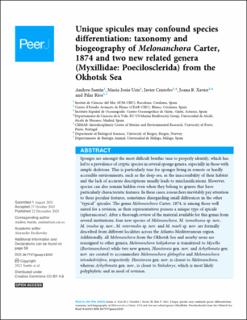| dc.description.abstract | Sponges are amongst the most difficult benthic taxa to properly identify, which has led to a prevalence of cryptic species in several sponge genera, especially in those with simple skeletons. This is particularly true for sponges living in remote or hardly accessible environments, such as the deep-sea, as the inaccessibility of their habitat and the lack of accurate descriptions usually leads to misclassifications. However, species can also remain hidden even when they belong to genera that have particularly characteristic features. In these cases, researchers inevitably pay attention to these peculiar features, sometimes disregarding small differences in the other “typical” spicules. The genus Melonanchora Carter, 1874, is among those well suited for a revision, as their representatives possess a unique type of spicule (spherancorae). After a thorough review of the material available for this genus from several institutions, four new species of Melonanchora, M. tumultuosa sp. nov., M. insulsa sp. nov., M. intermedia sp. nov. and M. maeli sp. nov. are formally described from different localities across the Atlanto-Mediterranean region. Additionally, all Melonanchora from the Okhotsk Sea and nearby areas are reassigned to other genera; Melonanchora kobjakovae is transferred to Myxilla (Burtonanchora) while two new genera, Hanstoreia gen. nov. and Arhythmata gen. nov. are created to accommodate Melonanchora globogilva and Melonanchora tetradedritifera, respectively. Hanstoreia gen. nov. is closest to Melonanchora, whereas Arhythmata gen. nov., is closer to Stelodoryx, which is most likely polyphyletic and in need of revision. | en_US |

